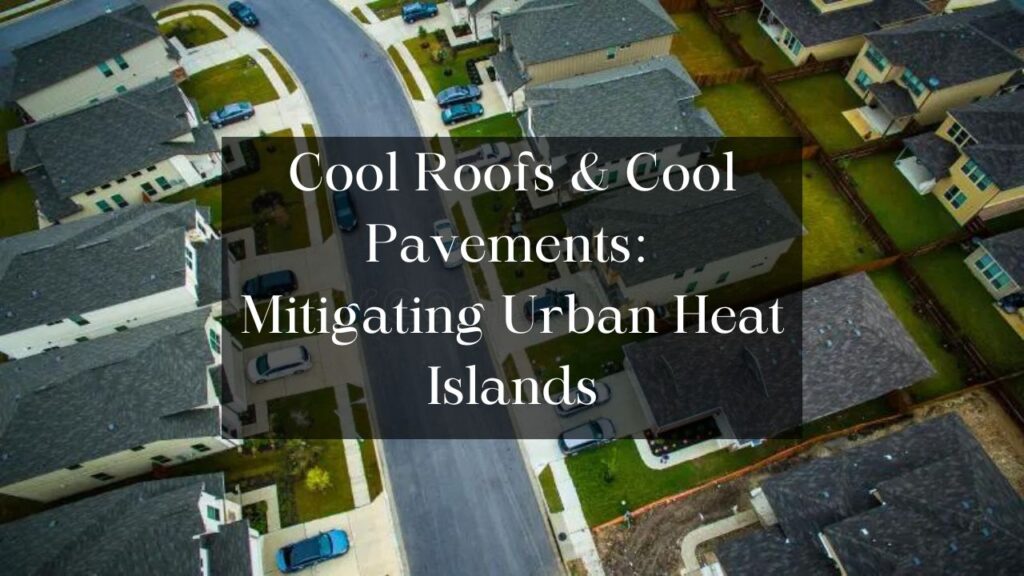Urban areas are often hotter than their rural surroundings. This phenomenon is known as the “urban heat island effect.” It can make cities significantly warmer, especially during the summer. Higher temperatures can have serious consequences for the people living in these cities and the environment as a whole.
Thankfully, there are ways to combat this heat island effect, and one of them is by using cool roofs and cool pavements. In this article, we’ll explore what these cool solutions are and how they can help make our cities cooler and more comfortable.
Understanding the Urban Heat Island Effect
Before we delve into cool roofs and cool pavements, it’s important to understand why urban heat islands happen. Urban areas are characterized by concrete buildings, asphalt roads, and other heat-absorbing surfaces. These surfaces can trap heat during the day and release it slowly at night, causing the city to stay warmer for longer.
Other factors contributing to the urban heat island effect include reduced vegetation, waste heat from buildings and vehicles, and the concentration of people and energy use.
All of these factors combine to create a heat island that can be several degrees hotter than the surrounding rural areas. This excessive heat can lead to a host of problems, including heat-related illnesses, increased energy consumption for cooling, and negative environmental impacts.
Cool Roofs: Keeping Things Chilled from the Top
Cool roofs are a key solution to mitigating urban heat islands. They work by reflecting more sunlight and absorbing less heat compared to standard roofs. They come in various forms, including white roofs, green roofs, and cool roofing materials.
White Roofs
One of the simplest and most effective cool roofing solutions is to paint roofs white. White surfaces reflect a large portion of the incoming sunlight, reducing the amount of heat absorbed by buildings. This means the interior of the building stays cooler, and less energy is needed for air conditioning.
Green Roofs
Green roofs are another innovative way to cool buildings and the surrounding area. These roofs are covered with vegetation, which provides insulation and shade. They also absorb rainwater, reducing runoff and improving air quality.
Cool Roofing Materials
Some roofing materials are designed to be naturally reflective and cool. These materials are manufactured to have high solar reflectance and high thermal emittance. This means they reflect more of the sun’s energy and release any absorbed heat quickly.
Cool Pavements: Keeping the Ground Cool
Just like cool roofs, cool pavements aim to reduce the amount of heat that urban surfaces absorb. Cool pavements are designed to reflect more sunlight and stay cooler. There are a few types of cool pavements:
Cool Asphalt
Traditional asphalt can absorb a lot of heat. Cool asphalt, on the other hand, is made with reflective materials or coatings that reduce heat absorption. These pavements can be a lighter color, or they can be treated with reflective coatings to make them more reflective.
Permeable Pavements
Permeable pavements allow water to pass through them, which helps cool the surface and reduce runoff. They are often made from materials like porous concrete or interlocking pavers, and they can be used in driveways, sidewalks, and parking lots.
Cool Pavement Coatings
Like cool roofing materials, cool pavement coatings are applied to existing pavements to increase their reflectivity and reduce heat absorption.
Benefits of Cool Roofs and Cool Pavements
Cool roofs and cool pavements offer a range of benefits that help combat the urban heat island effect:
- Reduced Energy Consumption: When buildings have cool roofs, they require less air conditioning during hot weather. This leads to lower energy bills and reduced greenhouse gas emissions.
- Lower Ambient Temperatures: Cool pavements and roofs help lower the overall temperature of urban areas. This can make cities more comfortable, especially during scorching summer months.
- Improved Air Quality: Cool pavements reduce the amount of heat generated by roads, which can contribute to smog formation. Cooler surfaces also help trees and vegetation thrive, contributing to cleaner air.
- Mitigation of Health Risks: By reducing extreme heat in urban areas, cool roofs and pavements help protect residents from heat-related illnesses and deaths.
- Enhanced Water Management: Green roofs and permeable pavements can help manage stormwater runoff and reduce flooding.
- Extended Roof and Pavement Lifespans: Cool roofs and pavements tend to have longer lifespans because they experience less thermal stress and wear and tear.
Challenges and Considerations
While cool roofs and cool pavements offer many benefits, there are also challenges and considerations to keep in mind:
- Cost: Installing cool roofs and pavements can be more expensive upfront compared to traditional materials. However, the long-term energy savings and other benefits can outweigh the initial costs.
- Maintenance: Some cool roofing and pavement solutions require more maintenance than traditional options, especially green roofs and permeable pavements.
- Regulations: In some areas, there may be building codes and regulations that restrict the use of certain roofing and pavement materials.
- Climate Considerations: The effectiveness of cool roofs and pavements can vary depending on the local climate and the amount of sunlight the area receives.
- Aesthetics: Some people may find the appearance of cool roofs and pavements less appealing than traditional options.
Some More Related Stories
Wrapping Up
Cool roofs and cool pavements are innovative solutions that can help mitigate the urban heat island effect, making our cities cooler and more comfortable places to live. By reducing heat absorption, they can lower energy consumption, improve air quality, and reduce the risk of heat-related illnesses.
While there are challenges to implementing these solutions, the long-term benefits for both people and the environment make them a promising approach to combatting urban heat islands.
As our cities continue to grow, it’s essential to consider the impact of our urban environment on temperature and explore ways to keep our cities cool and sustainable. Cool roofs and cool pavements are steps in the right direction toward a more comfortable and environmentally friendly urban future.
Frequently Asked Questions (FAQs)
1. What is an urban heat island (UHI) effect?
An urban heat island effect refers to the phenomenon where urban areas experience higher temperatures than their rural surroundings. This happens due to the heat-absorbing properties of buildings, roads, and other infrastructure, as well as the concentration of human activity and energy use in cities.
2. How do cool roofs work?
Cool roofs work by reflecting more sunlight and absorbing less heat compared to traditional roofs. They can be made from reflective materials, coated with reflective substances, or painted white. This reduces heat absorption, keeps buildings cooler, and decreases the need for air conditioning.
3. What are the benefits of cool roofs?
The benefits of cool roofs include reduced energy consumption, lower ambient temperatures in urban areas, improved air quality, mitigation of health risks related to extreme heat, enhanced water management, and extended roof lifespans.
4. What types of materials are used for cool roofs?
Cool roofs can be made using a variety of materials, including white roofing materials, cool roofing membranes, and reflective roof coatings. Some roofing materials are designed to have high solar reflectance and high thermal emittance to make them naturally reflective and cool.
5. Are cool roofs more expensive than traditional roofs?
Cool roofs may have higher upfront costs compared to traditional roofing materials. However, the long-term energy savings and other benefits often make them a cost-effective choice.
6. How do cool pavements help mitigate urban heat islands?
Cool pavements reduce heat absorption by reflecting more sunlight. They can be made from materials like cool asphalt, permeable pavements, or cool pavement coatings. This helps lower the overall temperature of urban areas and reduce heat-related issues.




Pingback: Why Every Business Needs an Energy Audit: Exploring the Benefits - Innoprudent